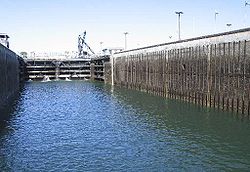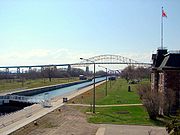
Soo Locks
Encyclopedia



Lock (water transport)
A lock is a device for raising and lowering boats between stretches of water of different levels on river and canal waterways. The distinguishing feature of a lock is a fixed chamber in which the water level can be varied; whereas in a caisson lock, a boat lift, or on a canal inclined plane, it is...
s which enable ship
Ship
Since the end of the age of sail a ship has been any large buoyant marine vessel. Ships are generally distinguished from boats based on size and cargo or passenger capacity. Ships are used on lakes, seas, and rivers for a variety of activities, such as the transport of people or goods, fishing,...
s to travel between Lake Superior
Lake Superior
Lake Superior is the largest of the five traditionally-demarcated Great Lakes of North America. It is bounded to the north by the Canadian province of Ontario and the U.S. state of Minnesota, and to the south by the U.S. states of Wisconsin and Michigan. It is the largest freshwater lake in the...
and the lower Great Lakes
Great Lakes
The Great Lakes are a collection of freshwater lakes located in northeastern North America, on the Canada – United States border. Consisting of Lakes Superior, Michigan, Huron, Erie, and Ontario, they form the largest group of freshwater lakes on Earth by total surface, coming in second by volume...
. They are located on the St. Marys River
St. Marys River (Michigan-Ontario)
The St. Marys River , sometimes written as the St. Mary's River, drains Lake Superior, starting at the end of Whitefish Bay and flowing 74.5 miles southeast into Lake Huron, with a fall of ....
between Lake Superior and Lake Huron
Lake Huron
Lake Huron is one of the five Great Lakes of North America. Hydrologically, it comprises the larger portion of Lake Michigan-Huron. It is bounded on the east by the Canadian province of Ontario and on the west by the state of Michigan in the United States...
, between the Upper Peninsula of the US
United States
The United States of America is a federal constitutional republic comprising fifty states and a federal district...
state of Michigan
Michigan
Michigan is a U.S. state located in the Great Lakes Region of the United States of America. The name Michigan is the French form of the Ojibwa word mishigamaa, meaning "large water" or "large lake"....
and the Canadian
Canada
Canada is a North American country consisting of ten provinces and three territories. Located in the northern part of the continent, it extends from the Atlantic Ocean in the east to the Pacific Ocean in the west, and northward into the Arctic Ocean...
province of Ontario
Ontario
Ontario is a province of Canada, located in east-central Canada. It is Canada's most populous province and second largest in total area. It is home to the nation's most populous city, Toronto, and the nation's capital, Ottawa....
. They bypass the rapids of the river, where the water falls 21 feet (7 m).
The locks pass an average of 10,000 ships per year, despite being closed during the winter from January through March, when ice shuts down shipping on the Great Lakes. The winter closure period is used to inspect and maintain the locks.
The locks share a name (usually shortened and anglicized as Soo) with the two cities named Sault Ste. Marie, in Ontario
Sault Ste. Marie, Ontario
Sault Ste. Marie is a city on the St. Marys River in Algoma District, Ontario, Canada. It is the third largest city in Northern Ontario, after Sudbury and Thunder Bay, with a population of 74,948. The community was founded as a French religious mission: Sault either means "jump" or "rapids" in...
and in Michigan
Sault Ste. Marie, Michigan
Sault Ste. Marie is a city in and the county seat of Chippewa County in the U.S. state of Michigan. It is in the north-eastern end of Michigan's Upper Peninsula, on the Canadian border, separated from its twin city of Sault Ste. Marie, Ontario, by the St. Marys River...
, located on either side of the St. Marys River. The Sault Ste. Marie International Bridge
Sault Ste. Marie International Bridge
The Sault Ste. Marie International Bridge, often known just as the International Bridge, spans the St. Marys River between the United States and Canada connecting the twin cities of Sault Ste. Marie, Michigan and Sault Ste. Marie, Ontario. It serves as the northern terminus of Interstate 75...
between the United States
United States
The United States of America is a federal constitutional republic comprising fifty states and a federal district...
and Canada
Canada
Canada is a North American country consisting of ten provinces and three territories. Located in the northern part of the continent, it extends from the Atlantic Ocean in the east to the Pacific Ocean in the west, and northward into the Arctic Ocean...
permits vehicular traffic to pass over the locks. A railroad bridge crosses the St. Marys River just upstream of the highway bridge.
U.S. Soo locks
The U.S. locks form part of a 1.6-mile (2.6-km) canal formally named the St. Mary's Falls Canal. The entire canal, including the locks, is owned and maintained by the United States Army Corps of EngineersUnited States Army Corps of Engineers
The United States Army Corps of Engineers is a federal agency and a major Army command made up of some 38,000 civilian and military personnel, making it the world's largest public engineering, design and construction management agency...
, which provides free passage. The first iteration of the U.S. Soo Locks was completed in May 1855, and operated by the State of Michigan
Michigan
Michigan is a U.S. state located in the Great Lakes Region of the United States of America. The name Michigan is the French form of the Ojibwa word mishigamaa, meaning "large water" or "large lake"....
until transferred to the U.S. Army in 1881.
The current configuration consists of four parallel lock chambers, each running east to west; starting at the Michigan shoreline and moving north toward Ontario, these are:
- The MacArthur Lock, built in 1943. It is 800 feet (244 m) long, 80 feet (24 m) wide, and 29.5 feet (9 m) deep. This is large enough to handle ocean-going vessels ("salties") that must also pass through the smaller locks in the Welland CanalWelland CanalThe Welland Canal is a ship canal in Canada that extends from Port Weller, Ontario, on Lake Ontario, to Port Colborne, Ontario, on Lake Erie. As a part of the St...
. The first vessel through was the SS Carl D. BradleySS Carl D. BradleyThe was a self-unloading Great Lakes freighter that sank in a storm on November 18, 1958. Of the 35 crew members, 33 died in the sinking and 23 were from the port town of Rogers City, Michigan. Her sinking was likely caused by structural failure from the brittle steel used in her...
.
- The Poe Lock, re-built in 1968, after the Saint Lawrence SeawaySaint Lawrence SeawayThe Saint Lawrence Seaway , , is the common name for a system of locks, canals and channels that permits ocean-going vessels to travel from the Atlantic Ocean to the North American Great Lakes, as far as Lake Superior. Legally it extends from Montreal to Lake Erie, including the Welland Canal...
opened. It is 1,200 feet (366 m) long, 110 feet (34 m) wide, and 32 feet (10 m) deep. It can take ships carrying 72,000 tonTonThe ton is a unit of measure. It has a long history and has acquired a number of meanings and uses over the years. It is used principally as a unit of weight, and as a unit of volume. It can also be used as a measure of energy, for truck classification, or as a colloquial term.It is derived from...
s of cargo. The Poe is the only lock that can handle the large lake freighterLake freighterLake freighters, or Lakers, are bulk carrier vessels that ply the Great Lakes. The best known was the , the most recent and largest major vessel to be wrecked on the Lakes. These vessels are traditionally called boats, although classified as ships. In the mid-20th century, 300 lakers worked the...
s used on the upper lakes. The first passage was by the Phillip R. Clarke in 1969. The original Poe Lock was engineered by Orlando PoeOrlando PoeOrlando Metcalfe Poe was an United States Army officer and engineer in the American Civil War. After helping General William Tecumseh Sherman's March to the Sea, he was responsible for much of the early lighthouse construction on the Great Lakes.-Early life:Poe was born in Navarre, Ohio...
and, at 800 feet long and 100 feet wide (244 x 30 m), was the largest in the world when completed in 1896.
- The Davis Lock, built in 1914. It is 1,350 feet (411 m) long, 80 feet (24 m) wide, and 23.1 feet (7 m) deep. This lock is used rather infrequently (only 5 commercial/private and 34 government vessel passages, on 14 October days, during 2008) to lock light freighters, tour boats, and small craft when traffic warrants. The SS James A Farrell was the first vessel to lock through.
- The Sabin Lock, built in 1919. It is 1,350 feet (411 m) long, 80 feet (24 m) wide, and 23.1 feet (7 m) deep. This lock has been placed in caretaker status and is no longer used.
The Davis and Sabin locks have been slated for replacement since 1986 with a new 'Super-Lock', which would provide a second lock capable of accommodating the "lakers". Groundbreaking for the new lock project was held on June 30, 2009, although the bulk of the funding necessary to complete the project has not yet been appropriated. This construction will further limit usage of the Davis Lock.
North of the Sabin Lock is an additional channel with a small hydroelectric plant that provides electricity for the lock complex.
Engineers Day
On the last Friday of every June, the public is allowed to go behind the security fence and cross the lock gates of the U.S. Soo Locks for the annual Engineers Day Open House. Visitors then are able to get close enough to the ships passing through the two regularly operating locks to touch them.Canadian Soo Lock

Further reading
- Taylor, Paul (October 2009) Orlando M. Poe: Civil War General and Great Lakes Engineer (Kent State University Press) ISBN 1606350404; ISBN 978-1606350409.
External links
Aerial views http://www.aerialpics.com/H/saultlocks.html- Soo Locks homepage U.S. Army Corps of Engineers Soo Locks page
- Web Camera view of the American locks NOTE: This Connection is Untrusted
- Animation of how the Soo Locks work.
- Soo Locks Visitors Center website
- YouTube video HD video of a ship passing through the MacArthur Lock

